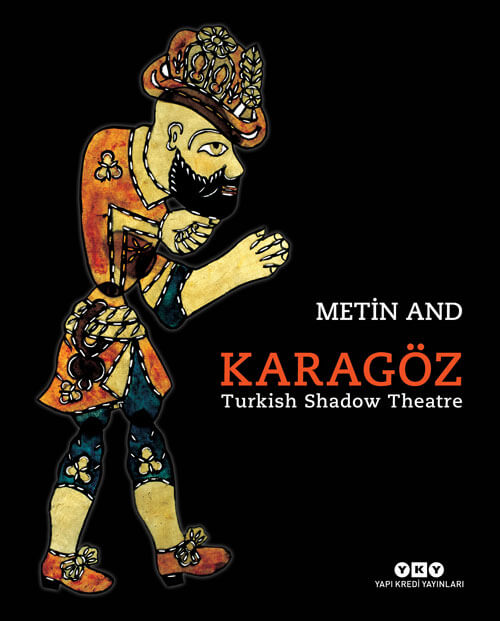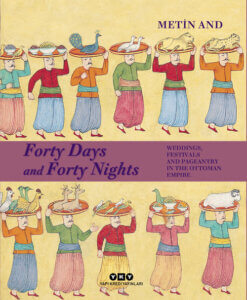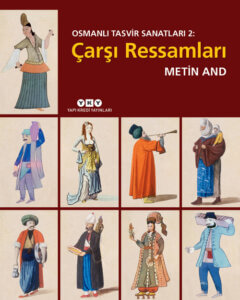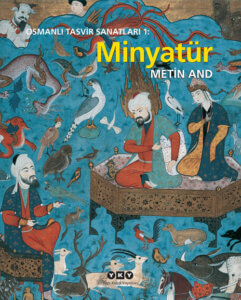
For over fifty years, Metin And championed Turkish theatre, traditional performing arts, festivities, and the art of Ottoman miniature in dozens of articles and titles in Turkish and other languages. In Karagöz: Turkish Shadow Theatre, originally written in English for an international audience in mind, he turns to one of the most original and colourful art forms that developed in and spread through the Ottoman Empire.
Starting with an overview of theatre traditions in Turkey, Metin And moves on to a thorough investigation of Karagöz, Turkish shadow theatre named after its protagonist: Its origins and development, the techniques involved in making of the figures and props, detailed studies of the stock characters and plots, and the form’s function as political comment in the Ottoman Empire, ending with an account of shadow theatre’s decline and later influence in the Westernizing Turkey. This revised edition includes full-colour reproductions of figures found in the rich Karagöz archive of Yapı Kredi Museum, as well as an appendix on the Turkish puppet and marionette theatre written by Metin And, the full text of a Karagöz play, and an interview with one of the last Karagöz performers in Turkey.
Highly informative and hugely entertaining, Karagöz: Turkish Shadow Theatre is an indispensable reference book on the subject.
Contents
A New Life for “the Shadow”, Immortality for “Karagöz” / M. Sabri Koz • 7
Preface • 11
Introduction: Four Traditions of Theatre in Turkey • 13
The Origins and the Development of Turkish Shadow Theatre • 39
Technique and Structure of Karagöz • 71
The Stock Characters in Karagöz • 91
Some Representative Karagöz Scenarios • 131
Karagöz as an Agitprop in the Empire • 181
Aftermath: The Decline and Later Influence of Karagöz • 197
Appendix 1: English Translation of a Play:
The Muddleheaded Night Watchman (Translated by Andreas Tietze) • 209
Appendix 2: Interview with Karagöz Player
Ragıp Tuğtekin (Interviewed by Nail Tan) • 239
Appendix 3: The Turkish Puppet and Marionette Theatre • 245
Bibliography • 267
Index • 270

A New Life for “the Shadow”,
Immortality for “Karagöz”
M. SABRİ KOZ
2004 was a fruitful year for Yapı Kredi Culture and Arts Publishing, elapsed with the blessing of Turkish shadow theatre, Karagöz. The production of “Yıktın Perdeyi Eyledin Vîrân / Yapı Kredi Karagöz Koleksiyonu // Torn is the curtain, shattered is the screen, the stage all in ruins! / Yapı Kredi Karagöz Collection” exhibition held in the Yapı Kredi Museum (known then as the Yapı Kredi Vedat Nedim Tör Museum); the exhibition catalogue, which was published as a book under the same title, later becoming an important source for anyone interested in the subject since its publication; and Cevdet Kudret’s (1907-1992) three-volume compilation named Karagöz – the preparation and the editing of these by Yapı Kredi Publications had taken almost a whole year. The short second to last paragraph of the introduction which I had written for Cevdet Kudret’s revised, appended and updated publication, titled “On the New Edition of Karagöz” included the following sentences:
This edition of Karagöz, which was prepared with the utmost care and attention, was enriched with the material and intellectual support of dear Metin And. With this project, we have seen how much it suits and enlarges some people to help.
Those who also get this edition of Karagöz will understand very well what I meant with these two sentences after seeing both Cevdet Kudret’s extraordinary wealth of work and the addition of missing texts that were not included in the first editions, having not been available, and the few notes added to these and to some other texts. Many of these were realized thanks to Metin And (1927-2008). And has achieved immortality with his competence on Turkish shadow theatre, more broadly called Karagöz, and his activities around the world from Japan to the United States of America, from Russia to China; his travels and studies, as well as his works written mainly in Turkish, English, and French. Metin And, as a mortal who is not among us today, who gained knowledge and the maturity stemming from knowledge, was a childlike sage who researched Turkish shadow theatre, Karagöz, in every environment as long as he lived and encouraged those who think, write and turn to solve issues related with the field. I, too, had received his love and support. While the exhibition, the catalogue, and Cevdet Kudret’s book were being prepared, he supported me not only with his books, articles, narratives and material aids but also with his incentives and guidance, and he continues to support me in his absence, with what he left behind. He especially wanted to include the “Selected Bibliography on Karagöz” in the catalogue of the exhibition, and he told me I could easily compile and gather it, and that I prepared with enthusiasm and care. The extended, updated new version (2013) of this work, even though he couldn’t see it, is the result of my efforts as well as his orientation, and will bear his traces after being published as a book soon. The shadow theatre tradition that spread from the Ottoman Empire in terms of language, character and technique and developed with similar and different characters in local languages in Europe, the Arabian peninsula and North Africa, continues in a form that has gained a national dimension in Greece, and Turkish shadow theatre characters live under the localized names of “Karaghiozis” for Karagöz and “Hatziavatis” for Hacivat. Karagöz: Turkish Shadow Theatre (1975, 1979) is an important handbook that was written to introduce and describe Karagöz, an imperial art, to those who do not speak Turkish, and the book fulfills its duty very well. There is also a French edition written by Metin And: Karagöz. Theater D’ombres Turc (Karagöz. Turkish Shadow Theatre, 1977). To this book adorned with black and white and colour paintings we wanted to breathe a new life. In addition to numerous scientific and promotional articles on the Turkish shadow theatre, Karagöz, Metin And also has the following books: A History of Theatre and Popular Entertainment in Turkey (1963- 1964), Traditional Turkish Theatre: Puppetry, Ortaoyunu, Karagöz (1969), Shadow Theatre in Turkey and in the World (1977), Traditional Turkish Theatre: Traditions of Peasant Theatre and Folk Theatre (1985). When the reprint of Karagöz: Turkish Shadow Theatre was on the agenda, I proposed to decorate it with figures –enough for almost every “Karagöz Faslı” (main plot)– found in the Yapı Kredi Museum (187 pieces). The artist Ragıp Tuğtekin (1892-1982), who made these figures, was an “old-time” man of many talents who lived in the past century. He worked as a teacher and director of sub-districts, and he understood music, calligraphy and painting. He learned to depict Karagöz from camel and calf leather from Tecelli Bey (?-1912), Yamalı Hakkı (?-?) and Nazif Efendi (second half of the 19th century-early 20th century). He also taught others to portray and play Karagöz as a tradition bearer and trained famous apprentices such as Ali Rıza Kıyak (1928-2015) and Orhan Kurt (1930-2017) who are not among us today. Many of today’s young or middle-aged Karagöz artists and figure cutters are students of Ragıp Tuğtekin’s apprentices who say that he produced up to twelve thousand figures. In one of his interviews (included in the present book with the consent of the interviewer), he states that he has three collections (one of which is enough to reflect the thirty known plays on the screen during the month of Ramadan) and adds that one of these sets is at the Yapı Kredi Museum, one is owned by Metin And and the last one is in Berlin, in the possession of the owner of a chemical factory. We don’t know anything about the collection in Berlin, the collection at the Yapı Kredi Museum stands as it is, while the Metin And Collection (along with other cutters’ figure collections) is scattered, most of which is preserved in the Karagöz Museum in Bursa.
To this edition of the Karagöz: Turkish Shadow Theatre, we added a play’s text (fasıl). This added text also has a story: One of the four valuable writings by Metin And for our exhibition catalogue (Torn is the curtain, shattered the screen, the stage all in ruins!) was titled “Karagöz, Hellmut Ritter and Andreas Tietze”. This article was about the services and contributions to Turkish shadow theatre by famous orientalist Hellmut Ritter (1892-1971), and Andreas Tietze (1914-2003), who produced many valuable works directly related to folklore and wrote an etymological dictionary of the Turkish language. Metin And praises the work of Ritter and Tietze and expresses his gratitude that the collections of well-known Karagöz masters such as Nazif Efendi and Kâtip Salih (1848?-?) were protected from disintegration. In the meantime, he adds that Tietze, who prepared an excellent catalogue of Kâtip Salih’s figure collection, also included a play’s text which he personally translated. His assessment on this subject is as follows:
But the most striking aspect is the English translation of a Karagöz chapter (Aptal Bekçi, ‘The Muddleheaded Night Watchman’). I couldn’t believe my eyes while reading this; Tietze had translated the puns there to match Karagöz exactly and translated the verses to English in the most perfect way.
It was Metin And himself who assured us in every respect and recommended that we include this translation of his friend with whom he had a very close relationship in his health and whom he commemorated with respect and admiration after his death. Now, with this proposal and assurance, we include this translation to Karagöz: Turkish Shadow Theatre as it is. I would like to thank Darmin Hadzibegoviç, who edited Metin And’s two previously published books in English and displayed a harmonious cooperation, and I respectfully commemorate everyone who is mentioned in this short article. God rest their souls!
Armutlu, 11 September 2019
Translated by Boğaç Erkan
Preface
The nature of Turkish shadow theatre, which grew out of many artistic traditions, has fascinated and baffled generations of travellers to the Middle East, and Karagöz has attracted a considerable number of enthusiastic scholars. Considering the growing interest in puppet and shadow theatre throughout the world, this study has a relevance that makes the book of interest to the general reader as well as to the specialist. Recently there has been a reawakening of interest in Asiatic shadow theatre. Today, many of traditional popular dramatic forms, in particular Karagöz, have been absorbed into or replaced by radio, movies and television, the media of contemporary mass culture. And it is certain that at this time, when the theatre, an art which perpetually renews itself, is looking for new means of expression, the example of Karagöz will be particularly immediate and of great help. The author would like to thank all those scholars, particularly Georg Jacob, Theodor Menzel, Ignác Kúnos and Hellmut Ritter, who have devoted themselves with enthusiasm to the study of Karagöz. While it was timely that particular aspects of Karagöz received the attention of these scholars, their monographs are invariably concerned with the form as folk literature, ignoring the transformation of the material into theatre and throwing but little light on the theatrical qualities inherent in the Turkish shadow theatre. The present work does in some measure remedy this defect, with the recognition that before anything else Karagöz is a theatrical form, and the distribution of emphasis was decided partly by this basic disciplinary bias. Although the material presented is based partly on works already published and on facts already known, with no attempt having been made to draw up a set of definitive conclusions, it yet presents a radically new approach to the subject.

Introduction:
Four Traditions of Theatre in Turkey
Theatrical art in Turkey is currently believed to have developed from the same religious, moral and educational urge to imitate human actions that accompanied its growth in other countries, particularly in ancient Greece. The shadow theatre, which involves casting the shadow of two-dimensional figures on a two-dimensional screen, had an important place in Turkey as well as throughout the larger area of the Ottoman Empire. To understand its place let us glance at four main traditions of theatre in Turkey. These are “the folk theatre tradition”, “the popular theatre tradition”, “the court theatre tradition”, and “the Western theatre tradition”. In order to understand the significance of Turkish shadow theatre, these deserve special brief study.
1. The Folk Theatre Tradition
The Turkish peasantry, which constituted for a long time about three quarters of the whole population, is the most homogenous and articulate element of the nation, and has throughout many centuries retained its own peculiar character. The isolation of Turkish villages has caused the preservation, in their unique forms, of traditional peasant dances, puppet shows and plays. During public festivals, a type of crude drama sometimes accompanies the singing, dancing and mime. This is most likely a legacy from ancient religious rites, handed down from generation to generation. Maybe it originated in the shamanistic rituals of the Ural-Altaic region, which was the birthplace of the Turkish
Bu kitabı en uygun fiyata Amazon'dan satın alın
Diğerlerini GösterBurada yer almak ister misiniz?
Satın alma bağlantılarını web sitenize yönlendirin.
- Kategori(ler) Sanat
- Kitap AdıKaragöz – Turkish Shadow Theatre
- Sayfa Sayısı272
- YazarMetin And
- ISBN9789750864834
- Boyutlar, Kapak22 x 27,5 cm, Karton Kapak
- YayıneviYapı Kredi Yayınları / 2025



